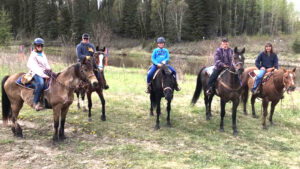Drayton Valley now has additional continuing care beds, offering Alberta Health Services’ highest level of supportive living.
The 12 new Supportive Living Level 4 (SL4) beds are located in the Seasons Retirement Community on 47 Street. They are designed for people with more complex medical needs that are predictable and can be safely managed. That includes instances where an individual may require chronic disease management and assistance with some daily activities.
Dr. Chris Birchall Dentistry
Share on facebook Facebook Share on email Email Share on linkedin LinkedIn Share on whatsapp

Emmaus Lutheran Church
“A community of faith passionately walking the road of life with the Lord Jesus” Phone:

Firearms repair and maintenance
Share on facebook Facebook Share on email Email Share on linkedin LinkedIn Share on whatsapp

B.D. Lock and Key Ltd.
Share on facebook Facebook Share on email Email Share on linkedin LinkedIn Share on whatsapp

Valley Worship Assembly
Please take your time and discover what is happening at Valley Worship in Drayton Valley.
Seasons expects to open 12 more SL4 beds in Drayton Valley over the next several months.
“This is a great benefit for Drayton Valley,” said MLA Mark Smith in a media release. “Residents can be confident that they, or their loved ones, will be provided a high level of supportive living care right here in the community.”
SL4 beds were first introduced to the community last summer, when Seasons transitioned 16 beds in Drayton Valley. The decision to offer this higher level of care was made following a thorough review, and consideration of current and future needs of the community.
“I’m proud of the work we’re doing to increase choices and options for seniors,” said Lori Sparrow, AHS Senior Operating Officer, Seniors Health, Central Zone. “Providing more Albertans the opportunity to age in place, in familiar surroundings near family and loved ones, is an important cornerstone of enhancing care in the community.”
Once all new beds are added, Drayton Valley will have 40 SL4 beds. The aim is to ensure residents continue to receive the appropriate level of care while staying in the community as their needs change.
It’s tax time in Canada, and while the costs of having taxes done aren’t a big deal to some, for others it can be prohibitive.
Gina Matalski, a tax specialist at GM Accounting and Tax Services, is working with Drayton Valley Family and Community Support Services to help those who struggle to afford having their taxes done.
Matalski says the Income Tax Program has volunteers in the community, who have received training provided by the Canada Revenue Agency, do the tax returns. She says people drop their information off at her office, and then a volunteer comes to get the information and files it.
“Then, if I don’t have time to do them myself, I contact the volunteers and let them know that there are some to be picked up,” she says.
Right now there are seven volunteers who have stepped forward to help out, but Matalski says the more people they have volunteering, the faster they can get things done.
While the program aims to help as many people as they can, Matalski says there are some restrictions for who can use the program, and only personal taxes can be done. She says anyone who has employment expenses, or anything outside of the norm, would not qualify for the program.
“It’s basic, basic income tax returns,” she says.
Individuals who wish to use the program must have less than $35,000 in taxable income for the year. Couples can use it if they make less than $45,000 and families cannot have more than $52,000 in earnings.
“This is my second year for the free tax program,” says Matalski, “but I’ve been doing personal tax returns for five years.”
Matalski says she signed on to the program because she wanted to help the community out.
She says the price for doing personal taxes can be high, depending on who is being used to file the taxes and it’s not fair for low income earners.
“When individuals and families that are already struggling to make ends meet every day have to go and pay between $150 and $200 to have a tax return done is ridiculous,” she says.
She said last year the program helped 500 individuals with their taxes.
Those who qualify for the program can drop their tax information off at 5136 – 54 St. on Tuesdays and Thursdays from 9 a.m. to 5 p.m.
School division looks a professional education
The Wild Rose School Division has been considering options for offering professional education for students.
At the January 23 board meeting, the Director of Instruction Jen Lefebvre presented trustees with an outline of different academies and collegiates the division could partner with.
The analysis report says academies are branded, specialized programs that don’t necessarily need an academy to put into place. Collegiates, which were announced as an official designation in Alberta Education in 2022, are schools that offer specialized programming that is geared toward guiding a student for different career paths.
Superintendent of WRSD, Brad Volkman, says there are many divisions that offer academy courses such as Flight Academies or Fire Academies and WRSD wanted to do some research on the feasibility of bringing some of these courses to the division.
Lefebvre brought an analysis that spoke about the benefits, drawbacks, and costs of some of those programs.
Volkman says one of the programs they were considering was a flight academy. However, since there is no funding from Alberta Education to help with the program, it would be too expensive to run.
“The cost is borne by the students,” says Volkman. “That includes instruction from a certified flight instructor, transportation costs to the airport, and there’s a pretty big insurance requirement.”
He says Lefebvre looked into different courses offered by other divisions and felt it was too much. “We’re hearing from some places that the cost is $20,000,” says Volkman.
After hearing the costs, the division felt there would be a limit as to which students could afford the enrollment for the course.
“Equity is very important to Wild Rose School Division, and we tend to not put a lot of resources into something that would impact only a few students who could most afford it.”
Volkman says while the flight academy is not an option at the moment, they are looking at other courses. One they were excited about was the firefighting training. According to the report, WRSD is currently looking to see if they can mitigate some of the transportation issues involved.
Frank Maddock High School is also partnering with Drayton Valley Ford as a focus for students in mechanics. Both Frank Maddock and Breton offer a full cosmetology course which helps students achieve apprenticeship level when they graduate. Breton also has received a grant to offer a welding program at the school.
Review examines wildfire response
The local response to last summer’s wildfire was generally well handled, but there are areas that need improvement.
That’s the conclusion of an after action review that came before Brazeau County council this week. The final report, which stretches over 40 pages, was prepared by Transitional Solutions Inc. of Sherwood Park, a company that was hired jointly by the County and the Town of Drayton Valley
“The primary objective of this wildfire after-action review is to conduct a thorough and impartial assessment of the incident response within the municipalities of Brazeau County and the Town of Drayton Valley, emphasizing a holistic approach aimed at learning, improving future responses, and fostering a culture of continuous enhancement within its firefighting and emergency management practices,” reads the introduction.
The review is based on interviews with 24 key stakeholders, along with a survey of municipal staff involved in the wildfire response, a tour of the area and an examination of relevant documents.
Major recommendations in the final report advocate for comprehensive training in Emergency Coordination Centre (ECC) setup, improving systems and processes, refining emergency plans, and developing proactive crisis communication strategies. For the Buck Creek Fire the ECC took three days to get set up and start running smoothly. That delay is blamed on a breakdown in communication.
“Council, Administration, and staff would greatly benefit from further understanding and utilizing the Incident Command System (ICS) and how it applies in situations like a wildfire event. Both Brazeau County and the Town of Drayton Valley need to utilize the quieter winter months before the start of the 2024 wildfire season to ensure compliance with legislation and have systems, services, and personnel ready, willing and with capacity to respond,” according to the report.
On Tuesday County CAO Kent Edney said steps had already been taken to address the areas highlighted in the report. That included making sure county staff were as well-prepared as possible in the event of a similar wildfire in the future.
“There’s quite a bit of training and activity that came from this report that’s going to be accomplished by the end of the month,” he said. “We should be in good shape by spring.
The review also has a lot of good things to say about how the fire was handled. This was an unprecedented event that escalated rapidly, providing a number of serious challenges, forcing the evacuation of more than 7,000 residents and threatening infrastructure and property valued in excess of $2 billion.
“It is imperative to emphasize the pivotal role played by municipal staff, first responders, and supporting agencies, who demonstrated collective cooperation, unwavering commitment to problem-solving, and relentless dedication,” says the report.”They supported the triumphant resolution of this unparalleled wildfire event. The success achieved in managing this crisis was inherently linked to the collaborative efforts and tireless determination demonstrated by responders, underscoring the significance of their integrated approach amidst some challenging circumstances.”
Edney said the full report would be posted on the County website.
Five teams leave league
The Alberta Junior Hockey League is now an 11 team organization. The defection of five breakaway teams to the British Columbia Hockey League was confirmed last week.
“We are disappointed – but not surprised – that the five defecting clubs now intend to drop out of the AJHL to immediately participate in an unsanctioned exhibition series,” the AJHL said in a statement.
The defecting teams are the Brooks Bandits, Okotoks Oilers, Blackfalds Bulldogs, Spruce Grove Saints and Sherwood Park Crusaders. In recent years those organizations have been the most successful in the AJHL. Prior to their defection, four of them occupied the top four places in the league standings for the current 2023-2024 season.
With the five teams now removed from the rankings, the Whitecourt Wolverines jump to top spot on 59 points. The Drayton Valley Thunder sit in tenth place on 34 points. Those two teams met in a rescheduled game on Sunday afternoon, with the Wolverines winning 3-0.
Last week the AJHL thanked the 11 remaining teams for their support as the league looked to move forward. It also indicated that it may be looking at adding more teams before too long.
“The AJHL has a strong future. We are grateful for the messages of support our players and coaches have received from hockey fans across the country over the past week,” the league said. “We also appreciate the expressions of interest coming from various partners and stakeholders who are exploring the possibility of becoming part of our great league.”
It’s still not clear what format the playoffs will take in the downsized AJHL. The regular season continues without the five clubs that are now part of the British Columbia League. That schedule sees the Thunder host the Calgary Canucks on Friday evening before heading to Olds on Sunday to take on the Grizzlys.
Firefighters recognized for service
Five active members and two retired members of Drayton Valley/Brazeau County Fire Services were awarded the Fire Services Exemplary Service Medal on behalf of the Governor General on November 26.
Retired firefighters Lieutenant Clifford Swan and Brad Charlton of the Breton station were awarded the 20 year service medal, along with Acting Battalion Chief Colin Bredin. Deputy Fire Chief Murray Galavan, Deputy Fire Chief Kamil Lasek, and Battalion Chief Mike Gramlich of the Drayton Valley station were all given their 20 year service medals, as well.
Battalion Chief Mark Raines of the Breton station was awarded his 1st bar for 30 years of service as he has already received an Exemplary Service Medal for 20 years of service.
The members were also congratulated at the November 29 town council meeting.
“That’s a big shout out,” says Mayor Nancy Dodds. “Thank you, and thank you to your families.”
Fire Chief Tom Thomson, who had the honour of nominating the award winners, says the medal isn’t just for the years of service that a firefighter has worked.
“You have to show exemplary service. You can’t just show up. You have to do more than that to receive the reward,” he says.
Even though Thomson nominated the members, they weren’t automatically awarded the medal. Each nomination form was reviewed by a selection committee to decide if they would receive the award.
“All of the members I nominated won,” says Thomson.
He says he chose those individuals because he has seen the effort they put into their positions. “All of them were selected because of their commitment and dedication to the department.”
Thomson says these members have demonstrated leadership, education of staff and the public, working toward fire prevention, and many other qualities that show their work ethic for Fire Services.
Thomson says these medals are normally awarded annually, but with Covid and the passing of Her Majesty Queen Elizabeth II, it has been a few years since they were given out.
Mom shares tragic story
“Complacency is dangerous” is the message Drayton resident Maureen Hollingsworth wants to spread.
Hollingsworth, who is a truck driver in the oil and gas industry, had her first opportunity to share her son’s story at a safety meeting held by Plains Midstream on November 15.
“Twelve years, five months, and ten days ago, my life changed,” she says.
On June 5, 2011, her son Colin Stewart, better known as Mouse, went to work in the morning, but didn’t come home in the evening. At the age of 23, Mouse had made a fatal choice at work and forever changed the lives around him.
“It was the day my heart was broken. It was also the day I had to start living without one of my greatest gifts,” says Hollingsworth.
For those in attendance, Hollingsworth shared anecdotes of Mouse. Though he had started out as a premie, Mouse had lived every day to the fullest.
Hollingsworth says that he was always active. He could be found quadding, dirtbiking, horseback riding, and snowmobiling most days. During his downtime, Mouse read.
“He would read anywhere,” says Hollingsworth.
Mouse also had a nephew Xzander, and he spent as much time with him as he could. Whenever possible, Mouse was buying Xzander gifts, many of which were playstation games.
Hollingsworth says the spring of 2011 was very wet. With all of the rain, Mouse couldn’t be out working.
Finally, at the end of May, the weather improved and Mouse and three others went to work.
For ten days the four guys, all aged between 19 and 23, were working long hours. It wasn’t unusual for a day to be 18-20 hours long.
“Not only are they over-houred and fatigued, let’s throw a whole lot of inexperience into the picture,” says Hollingsworth.
One of the 19-year-olds working that day had only been in Canada for five days.
“It’s now a Sunday afternoon and the job is completed. They were done early and were excited to go home. But that’s when complacency came into the picture,” she says.
Mouse’s machine was across the job site. He was tired. So, he hopped onto the back of another machine to catch a ride over to the other side of the job site.
The 19-year-old who was new to Canada, hopped into that machine. He didn’t know where everyone was on the site, and he didn’t walk around his equipment. Instead, he got in, flipped the switch, and that was the end for Mouse.
“Four went to work,” says Hollingsworth. “Three came home. Had [the driver] taken less than one minute and walked around the equipment, I wouldn’t be here talking about safety.”
Hollingsworth says after she was done speaking, Dan Lyons, the man who’d invited her to speak stood to say something. But after a moment of struggling to speak, he suggested a ten minute break for everyone.
“He told me he will never ever forget this,” says Hollingsworth.
She says one of the biggest frustrations she has with the situation is that people always want to know what kind of machine it was or where Mouse was working. For her, it doesn’t matter where it happened or what he was doing. The same lesson can be applied to all industries.
But she says that when she shares it was an industrial farming incident, many act as though that makes the situation non-applicable. Though Mouse died because he wanted to hitch a ride on a manure spreader, the situation is still the same in other industries. There was no walk around, no knowledge of where everyone was, and there was complacency on the worksite.
In 2011, farmers and ranch workers were still exempted from the Labour Code. There were no requirements for safety and they were not covered under the Occupational Health and Safety Act. In fact, when OH&S found out that his death was from a farming accident, they said there was nothing they could do.
“At that time there was no farm safety. None. Zero,” says Hollingsworth.
According to a blog written by Jennifer Koshan of the Faculty of Law at the University of Calgary, a study done by the Alberta Federation of Labour in 2017 showed “agricultural workers are more than twice as likely to be killed on the job as other workers in Alberta, and 4,000 work related injuries occur on Alberta farms each year.”
It wasn’t until Bill 6 was brought in by the Alberta Government in 2016 that things began to change for the farming industry. Now employers are required to have safety practices and are expected to meet the Alberta Occupation Health and Safety Act requirements for their industry.
“Bill 6 also brought farm and ranch workers who are paid, non-family members into the basic health and safety protections under the Occupational Health and Safety Act as of January 1, 2016. Farm and ranch employers are now obliged to ensure the health and safety of their workers, and the workers are able to refuse unsafe work that presents an imminent danger. OHS officers are authorized to inspect farm and ranch workplaces to ensure that that work is not being carried out in a manner that is unhealthy or unsafe, and serious injuries and accidents on farm and ranch work sites must be reported and investigated,” says Koshan’s article.
After the accident, Hollingsworth and Mouse’s dad Marvin Stewart spoke with the young man who’d been working the manure spreader that day. She says she felt awful for him because he was thousands of miles away from home. “He couldn’t even get a hug from his mom,” she says.
They made it clear to him that Mouse should never have been on the back of the spreader. They told him that Mouse knew better, and that he shouldn’t blame himself for what happened.
“I don’t want another mom to hear these words, ‘Your child has died due to safety reasons,’” she says. “I never want another mother to get a call from her kid saying he just killed someone at work.”
While it’s too late to help Mouse, Hollingsworth says she hopes she can spread the message far and wide. She is already slated to speak at two safety meetings at All Choice Rentals and hopes she has the opportunity to do more.
“We are excited to increase our capacity for care,” said Nicole Almost, Senior Regional Director, Resident and Guest Services, Seasons Retirement Communities. “We have continued to see the demand for this level of care rise, and this allows us to support even more residents and help keep more people in their local community.”
It’s tax time in Canada, and while the costs of having taxes done aren’t a big deal to some, for others it can be prohibitive.
Gina Matalski, a tax specialist at GM Accounting and Tax Services, is working with Drayton Valley Family and Community Support Services to help those who struggle to afford having their taxes done.
Matalski says the Income Tax Program has volunteers in the community, who have received training provided by the Canada Revenue Agency, do the tax returns. She says people drop their information off at her office, and then a volunteer comes to get the information and files it.
“Then, if I don’t have time to do them myself, I contact the volunteers and let them know that there are some to be picked up,” she says.
Right now there are seven volunteers who have stepped forward to help out, but Matalski says the more people they have volunteering, the faster they can get things done.
While the program aims to help as many people as they can, Matalski says there are some restrictions for who can use the program, and only personal taxes can be done. She says anyone who has employment expenses, or anything outside of the norm, would not qualify for the program.
“It’s basic, basic income tax returns,” she says.
Individuals who wish to use the program must have less than $35,000 in taxable income for the year. Couples can use it if they make less than $45,000 and families cannot have more than $52,000 in earnings.
“This is my second year for the free tax program,” says Matalski, “but I’ve been doing personal tax returns for five years.”
Matalski says she signed on to the program because she wanted to help the community out.
She says the price for doing personal taxes can be high, depending on who is being used to file the taxes and it’s not fair for low income earners.
“When individuals and families that are already struggling to make ends meet every day have to go and pay between $150 and $200 to have a tax return done is ridiculous,” she says.
She said last year the program helped 500 individuals with their taxes.
Those who qualify for the program can drop their tax information off at 5136 – 54 St. on Tuesdays and Thursdays from 9 a.m. to 5 p.m.
The Wild Rose School Division has been considering options for offering professional education for students.
At the January 23 board meeting, the Director of Instruction Jen Lefebvre presented trustees with an outline of different academies and collegiates the division could partner with.
The analysis report says academies are branded, specialized programs that don’t necessarily need an academy to put into place. Collegiates, which were announced as an official designation in Alberta Education in 2022, are schools that offer specialized programming that is geared toward guiding a student for different career paths.
Superintendent of WRSD, Brad Volkman, says there are many divisions that offer academy courses such as Flight Academies or Fire Academies and WRSD wanted to do some research on the feasibility of bringing some of these courses to the division.
Lefebvre brought an analysis that spoke about the benefits, drawbacks, and costs of some of those programs.
Volkman says one of the programs they were considering was a flight academy. However, since there is no funding from Alberta Education to help with the program, it would be too expensive to run.
“The cost is borne by the students,” says Volkman. “That includes instruction from a certified flight instructor, transportation costs to the airport, and there’s a pretty big insurance requirement.”
He says Lefebvre looked into different courses offered by other divisions and felt it was too much. “We’re hearing from some places that the cost is $20,000,” says Volkman.
After hearing the costs, the division felt there would be a limit as to which students could afford the enrollment for the course.
“Equity is very important to Wild Rose School Division, and we tend to not put a lot of resources into something that would impact only a few students who could most afford it.”
Volkman says while the flight academy is not an option at the moment, they are looking at other courses. One they were excited about was the firefighting training. According to the report, WRSD is currently looking to see if they can mitigate some of the transportation issues involved.
Frank Maddock High School is also partnering with Drayton Valley Ford as a focus for students in mechanics. Both Frank Maddock and Breton offer a full cosmetology course which helps students achieve apprenticeship level when they graduate. Breton also has received a grant to offer a welding program at the school.
The local response to last summer’s wildfire was generally well handled, but there are areas that need improvement.
That’s the conclusion of an after action review that came before Brazeau County council this week. The final report, which stretches over 40 pages, was prepared by Transitional Solutions Inc. of Sherwood Park, a company that was hired jointly by the County and the Town of Drayton Valley
“The primary objective of this wildfire after-action review is to conduct a thorough and impartial assessment of the incident response within the municipalities of Brazeau County and the Town of Drayton Valley, emphasizing a holistic approach aimed at learning, improving future responses, and fostering a culture of continuous enhancement within its firefighting and emergency management practices,” reads the introduction.
The review is based on interviews with 24 key stakeholders, along with a survey of municipal staff involved in the wildfire response, a tour of the area and an examination of relevant documents.
Major recommendations in the final report advocate for comprehensive training in Emergency Coordination Centre (ECC) setup, improving systems and processes, refining emergency plans, and developing proactive crisis communication strategies. For the Buck Creek Fire the ECC took three days to get set up and start running smoothly. That delay is blamed on a breakdown in communication.
“Council, Administration, and staff would greatly benefit from further understanding and utilizing the Incident Command System (ICS) and how it applies in situations like a wildfire event. Both Brazeau County and the Town of Drayton Valley need to utilize the quieter winter months before the start of the 2024 wildfire season to ensure compliance with legislation and have systems, services, and personnel ready, willing and with capacity to respond,” according to the report.
On Tuesday County CAO Kent Edney said steps had already been taken to address the areas highlighted in the report. That included making sure county staff were as well-prepared as possible in the event of a similar wildfire in the future.
“There’s quite a bit of training and activity that came from this report that’s going to be accomplished by the end of the month,” he said. “We should be in good shape by spring.
The review also has a lot of good things to say about how the fire was handled. This was an unprecedented event that escalated rapidly, providing a number of serious challenges, forcing the evacuation of more than 7,000 residents and threatening infrastructure and property valued in excess of $2 billion.
“It is imperative to emphasize the pivotal role played by municipal staff, first responders, and supporting agencies, who demonstrated collective cooperation, unwavering commitment to problem-solving, and relentless dedication,” says the report.”They supported the triumphant resolution of this unparalleled wildfire event. The success achieved in managing this crisis was inherently linked to the collaborative efforts and tireless determination demonstrated by responders, underscoring the significance of their integrated approach amidst some challenging circumstances.”
Edney said the full report would be posted on the County website.
The Alberta Junior Hockey League is now an 11 team organization. The defection of five breakaway teams to the British Columbia Hockey League was confirmed last week.
“We are disappointed – but not surprised – that the five defecting clubs now intend to drop out of the AJHL to immediately participate in an unsanctioned exhibition series,” the AJHL said in a statement.
The defecting teams are the Brooks Bandits, Okotoks Oilers, Blackfalds Bulldogs, Spruce Grove Saints and Sherwood Park Crusaders. In recent years those organizations have been the most successful in the AJHL. Prior to their defection, four of them occupied the top four places in the league standings for the current 2023-2024 season.
With the five teams now removed from the rankings, the Whitecourt Wolverines jump to top spot on 59 points. The Drayton Valley Thunder sit in tenth place on 34 points. Those two teams met in a rescheduled game on Sunday afternoon, with the Wolverines winning 3-0.
Last week the AJHL thanked the 11 remaining teams for their support as the league looked to move forward. It also indicated that it may be looking at adding more teams before too long.
“The AJHL has a strong future. We are grateful for the messages of support our players and coaches have received from hockey fans across the country over the past week,” the league said. “We also appreciate the expressions of interest coming from various partners and stakeholders who are exploring the possibility of becoming part of our great league.”
It’s still not clear what format the playoffs will take in the downsized AJHL. The regular season continues without the five clubs that are now part of the British Columbia League. That schedule sees the Thunder host the Calgary Canucks on Friday evening before heading to Olds on Sunday to take on the Grizzlys.
Five active members and two retired members of Drayton Valley/Brazeau County Fire Services were awarded the Fire Services Exemplary Service Medal on behalf of the Governor General on November 26.
Retired firefighters Lieutenant Clifford Swan and Brad Charlton of the Breton station were awarded the 20 year service medal, along with Acting Battalion Chief Colin Bredin. Deputy Fire Chief Murray Galavan, Deputy Fire Chief Kamil Lasek, and Battalion Chief Mike Gramlich of the Drayton Valley station were all given their 20 year service medals, as well.
Battalion Chief Mark Raines of the Breton station was awarded his 1st bar for 30 years of service as he has already received an Exemplary Service Medal for 20 years of service.
The members were also congratulated at the November 29 town council meeting.
“That’s a big shout out,” says Mayor Nancy Dodds. “Thank you, and thank you to your families.”
Fire Chief Tom Thomson, who had the honour of nominating the award winners, says the medal isn’t just for the years of service that a firefighter has worked.
“You have to show exemplary service. You can’t just show up. You have to do more than that to receive the reward,” he says.
Even though Thomson nominated the members, they weren’t automatically awarded the medal. Each nomination form was reviewed by a selection committee to decide if they would receive the award.
“All of the members I nominated won,” says Thomson.
He says he chose those individuals because he has seen the effort they put into their positions. “All of them were selected because of their commitment and dedication to the department.”
Thomson says these members have demonstrated leadership, education of staff and the public, working toward fire prevention, and many other qualities that show their work ethic for Fire Services.
Thomson says these medals are normally awarded annually, but with Covid and the passing of Her Majesty Queen Elizabeth II, it has been a few years since they were given out.
“Complacency is dangerous” is the message Drayton resident Maureen Hollingsworth wants to spread.
Hollingsworth, who is a truck driver in the oil and gas industry, had her first opportunity to share her son’s story at a safety meeting held by Plains Midstream on November 15.
“Twelve years, five months, and ten days ago, my life changed,” she says.
On June 5, 2011, her son Colin Stewart, better known as Mouse, went to work in the morning, but didn’t come home in the evening. At the age of 23, Mouse had made a fatal choice at work and forever changed the lives around him.
“It was the day my heart was broken. It was also the day I had to start living without one of my greatest gifts,” says Hollingsworth.
For those in attendance, Hollingsworth shared anecdotes of Mouse. Though he had started out as a premie, Mouse had lived every day to the fullest.
Hollingsworth says that he was always active. He could be found quadding, dirtbiking, horseback riding, and snowmobiling most days. During his downtime, Mouse read.
“He would read anywhere,” says Hollingsworth.
Mouse also had a nephew Xzander, and he spent as much time with him as he could. Whenever possible, Mouse was buying Xzander gifts, many of which were playstation games.
Hollingsworth says the spring of 2011 was very wet. With all of the rain, Mouse couldn’t be out working.
Finally, at the end of May, the weather improved and Mouse and three others went to work.
For ten days the four guys, all aged between 19 and 23, were working long hours. It wasn’t unusual for a day to be 18-20 hours long.
“Not only are they over-houred and fatigued, let’s throw a whole lot of inexperience into the picture,” says Hollingsworth.
One of the 19-year-olds working that day had only been in Canada for five days.
“It’s now a Sunday afternoon and the job is completed. They were done early and were excited to go home. But that’s when complacency came into the picture,” she says.
Mouse’s machine was across the job site. He was tired. So, he hopped onto the back of another machine to catch a ride over to the other side of the job site.
The 19-year-old who was new to Canada, hopped into that machine. He didn’t know where everyone was on the site, and he didn’t walk around his equipment. Instead, he got in, flipped the switch, and that was the end for Mouse.
“Four went to work,” says Hollingsworth. “Three came home. Had [the driver] taken less than one minute and walked around the equipment, I wouldn’t be here talking about safety.”
Hollingsworth says after she was done speaking, Dan Lyons, the man who’d invited her to speak stood to say something. But after a moment of struggling to speak, he suggested a ten minute break for everyone.
“He told me he will never ever forget this,” says Hollingsworth.
She says one of the biggest frustrations she has with the situation is that people always want to know what kind of machine it was or where Mouse was working. For her, it doesn’t matter where it happened or what he was doing. The same lesson can be applied to all industries.
But she says that when she shares it was an industrial farming incident, many act as though that makes the situation non-applicable. Though Mouse died because he wanted to hitch a ride on a manure spreader, the situation is still the same in other industries. There was no walk around, no knowledge of where everyone was, and there was complacency on the worksite.
In 2011, farmers and ranch workers were still exempted from the Labour Code. There were no requirements for safety and they were not covered under the Occupational Health and Safety Act. In fact, when OH&S found out that his death was from a farming accident, they said there was nothing they could do.
“At that time there was no farm safety. None. Zero,” says Hollingsworth.
According to a blog written by Jennifer Koshan of the Faculty of Law at the University of Calgary, a study done by the Alberta Federation of Labour in 2017 showed “agricultural workers are more than twice as likely to be killed on the job as other workers in Alberta, and 4,000 work related injuries occur on Alberta farms each year.”
It wasn’t until Bill 6 was brought in by the Alberta Government in 2016 that things began to change for the farming industry. Now employers are required to have safety practices and are expected to meet the Alberta Occupation Health and Safety Act requirements for their industry.
“Bill 6 also brought farm and ranch workers who are paid, non-family members into the basic health and safety protections under the Occupational Health and Safety Act as of January 1, 2016. Farm and ranch employers are now obliged to ensure the health and safety of their workers, and the workers are able to refuse unsafe work that presents an imminent danger. OHS officers are authorized to inspect farm and ranch workplaces to ensure that that work is not being carried out in a manner that is unhealthy or unsafe, and serious injuries and accidents on farm and ranch work sites must be reported and investigated,” says Koshan’s article.
After the accident, Hollingsworth and Mouse’s dad Marvin Stewart spoke with the young man who’d been working the manure spreader that day. She says she felt awful for him because he was thousands of miles away from home. “He couldn’t even get a hug from his mom,” she says.
They made it clear to him that Mouse should never have been on the back of the spreader. They told him that Mouse knew better, and that he shouldn’t blame himself for what happened.
“I don’t want another mom to hear these words, ‘Your child has died due to safety reasons,’” she says. “I never want another mother to get a call from her kid saying he just killed someone at work.”
While it’s too late to help Mouse, Hollingsworth says she hopes she can spread the message far and wide. She is already slated to speak at two safety meetings at All Choice Rentals and hopes she has the opportunity to do more.

Concern over Winfield School
The parent advisory council at Winfield Elementary are worried about the future of their school.

County spends on fire suppression
Brazeau County is set to spend $560,000 to improve fire suppression in two underserved parts of the municipality. Last week council approved $250,000 for a 210 cubic metre concrete water tank in Lindale and $310,000 for a similar tank and water well in Buck Creek.
Tax help is here
Matalski says the Income Tax Program has volunteers in the community, who have received training provided by the Canada Revenue Agency, do the tax returns. She says people drop their information off at her office, and then a volunteer comes to get the information and files it.

School division looks a professional education
Frank Maddock High School is also partnering with Drayton Valley Ford as a focus for students in mechanics. Both Frank Maddock and Breton offer a full cosmetology course which helps students achieve apprenticeship level when they graduate. Breton also has received a grant to offer a welding program at the school.

















